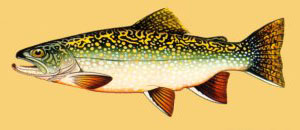Description
This fish is an artificial hybrid, of a male Salvelinus fontinalis (Brook Trout) X female S. namaycush (Lake Trout) (Becker 1983).
Common Names - The common name is a combinations of 'Speckled Trout' (a Canadian name for S. fontinalis) and 'Lake Trout' (Scott and Crossman 1973).
Taxonomy
| Kingdom | Phylum | Class | Order | Family | Genus |
|---|---|---|---|---|---|
| Animalia | Chordata | Osteichthyes | Salmoniformes | Salmonidae | Salvelinus |
Synonyms
Invasion History
Chesapeake Bay Status
| First Record | Population | Range | Introduction | Residency | Source Region | Native Region | Vectors |
|---|---|---|---|---|---|---|---|
| 1993 | Unknown | Unknown | Introduced | Boundary Resident | North America | North America | Fisheries(Fisheries Intentional) |
History of Spread
Salvelinus fontinalis X Salvelinus namaycush ('Splake' Trout) was produced as early as 1884 in WI hatcheries (Becker 1983), and extensively stocked in North America, in 12 US states, and especially in Ontario, where they have been selectively bred (Fuller et al. 1999; Scott and Crossman 1973). This hybrid was presumably an attempt to combine the size of S. namaycush with the feistiness of S. fontinalis, and is intermediate in habitat preference, and is also fertile (Becker 1983; Scott and Crossman 1973). It is not listed by Mills et al. 1993 as an introduction to the Great Lakes Basin, but has been widely stocked there (Fuller et al. 1999).
Susquehanna River - 'Splake' have presumably been stocked somewhere in the Susquehanna drainage in PA or NY, although PA introductions are not listed by Fuller et al. (1999). They have been stocked in unspecified regions of NY (Fuller et al. (1999). A few fish (1-5/year) have recently been collected below Conowingo Dam (Susquehanna River Anadromous Fish Restoration Committee 1996). This hybrid is unlikely to penetrate far into the Chesapeake Bay, or to reproduce except in reservoirs in the upper parts of the drainage.
History References - Becker 1983; Fuller et al. 1999; Mills et al. 1993; Scott and Crossman 1973; Susquehanna River Anadromous Fish Restoration Committee 1996
Invasion Comments
Ecology
Environmental Tolerances
| For Survival | For Reproduction | |||
|---|---|---|---|---|
| Minimum | Maximum | Minimum | Maximum | |
| Temperature (ºC) | 0.0 | 24.0 | ||
| Salinity (‰) | 0.0 | 0.0 | 0.0 | |
| Oxygen | ||||
| pH | ||||
| Salinity Range | fresh-oligo |
Age and Growth
| Male | Female | |
|---|---|---|
| Minimum Adult Size (mm) | ||
| Typical Adult Size (mm) | ||
| Maximum Adult Size (mm) | ||
| Maximum Longevity (yrs) | ||
| Typical Longevity (yrs |
Reproduction
| Start | Peak | End | |
|---|---|---|---|
| Reproductive Season | |||
| Typical Number of Young Per Reproductive Event |
|||
| Sexuality Mode(s) | |||
| Mode(s) of Asexual Reproduction |
|||
| Fertilization Type(s) | |||
| More than One Reproduction Event per Year |
|||
| Reproductive Startegy | |||
| Egg/Seed Form |
Impacts
Economic Impacts in Chesapeake Bay
Salvelinus fontinalis X Salvelinus namaycush (Splake Trout) is only a rare stray in the Susquehanna River, and has no economic impacts in the Chesapeake Bay, or its watershed.
Economic Impacts Outside of Chesapeake Bay
Salvelinus fontinalis X Salvelinus namaycush (Splake Trout) is widely stocked in coldwater lakes in North America, since it its faster growing and less vulnerable to attacks of Petromyzon marinus (Sea Lamprey) than its parents (Becker 1983; Scott and Crossman 1973). These hybrids have been stocked in at least 13 states (Fuller et al. 1999).
References- Becker 1983; Fuller et al. 1999; Scott and Crossman 1973
Ecological Impacts on Chesapeake Native Species
Salvelinus fontinalis X Salvelinus namaycush (Splake Trout) is too rare in the Chesapeake region to have significant effects on native Chesapeake biota.
Ecological Impacts on Other Chesapeake Non-Native Species
Salvelinus fontinalis X Salvelinus namaycush (Splake Trout) is too rare in the Chesapeake region to have significant effects on introduced Chesapeake biota.
References
Becker, George C. (1983) Fishes of Wisconsin, , Madison. Pp.Carlander, Kenneth D. (1969) Handbook of freshwater fishery biology. Vol. 1., In: (Eds.) . , Ames. Pp.
Fuller, Pam. L.; Nico, Leo; Williams, J. D. (1999) Nonindigenous fishes introduced into inland waters of the United States, , Bethesda MD. Pp.
Jenkins, Robert E.; Burkhead, Noel M. (1993) Freshwater fishes of Virginia., , Bethesda, MD. Pp.
Mills, Edward L.; Leach, Joseph H.; Carlton, James T.; Secor, Carol L. (1993) Exotic species in the Great Lakes: a history of biotic crises and anthropogenic introductions., Journal of Great Lakes Research 19: 1-54
Scott, W. B.; Crossman, E. J. (1973) Freshwater fishes of Canada, , Ottawa. Pp.
Susquehanna River Anadromous Fish Restoration Committee (1996) Restoration of American Shad to the Susquehanna River, , . Pp.
